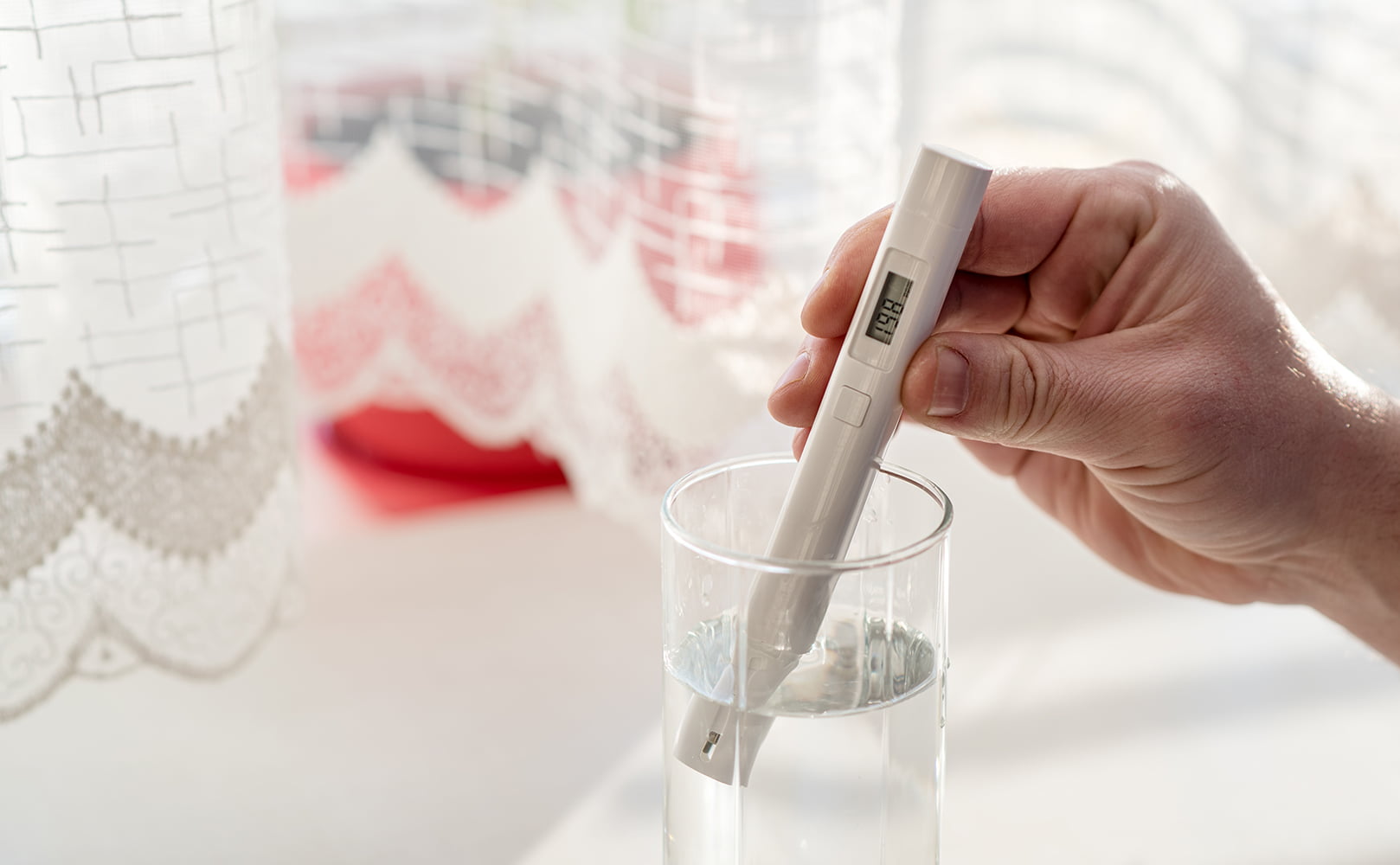How to Test Reverse Osmosis Water Quality (Purity) at Home
Written by: Alexandra Uta // Last Updated: Aug 2, 2023
This page may contain affiliate links. If you buy a product or service through such a link we earn a commission at no extra cost to you. Learn more.
Seeing as a lot of contaminants in water cannot be seen, tasted, or smelled, it makes sense that you might sometimes wonder if your reverse osmosis membrane is actually filtering out nasties like it is supposed to.
This comes down to the question how to test reverse osmosis water quality at home.
Thankfully, there are a few different ways which this article is all about!
Key Takeaways
A TDS meter is the best way to test your RO water quality at home. Here is how:
- Remove the cover from the tester and turn it on.
- Insert the tip of the tester into the filtered water around ½ an inch.
- Check the number (ppm value) on the display.
- Repeat the same steps with the feed water.
- Use the rejection rate calculation to determine the performance of the RO membrane.
How to Test RO Water Purity Using a TDS Meter
So, how to check RO water purity at home?
The best way to test RO water purity at home is by using a TDS meter. This device measures how many ions are left in your water, and it can be done before filtration and after, to determine if your RO membrane is working effectively.
TDS stands for total dissolved solids, and a TDS meter measures the amount of all the dissolved solids in water as a measure of parts per million (ppm). However, a TDS meter will not tell you specifically which kind of TDS are in your water.
In order to use a TDS meter, you need to do the following:
- Remove the cover from the tester and turn it on. Ensure that the display reads “000”.
- Insert the now uncovered tip of the tester into the water you want to check around ½ inch.
- Check the number on the display. You will see a ppm value, which indicates the number of total dissolved solids that are in the water.
- Remove the tester, dry it off and turn it off.
- There may be other buttons on the TDS reader, such as a button to measure the water temperature and one to lock the number on the meter so it doesn’t go away when you remove the meter from the water.
- Most testers will come readily calibrated.
Reverse Osmosis Membrane Performance Formula
In simple terms, the RO membrane performance formula is a way to calculate how well the process of removing contaminants from water is working.
For example, if you measure your feed water and your filtered RO water, then use the following formula and end up with a value of 95%, that means there are 95% fewer contaminants in your filtered water than in your feed water. Generally, you should replace your RO membrane if the percentage value falls below 80-90.
The formula to calculate the TDS rejection rate is:
Rejection rate % = (TDS of untreated water – TDS of purified RO water) / TDS of untreated water x 100
Other Ways to Check Reverse Osmosis Water Quality
There are several other ways you can check your RO water quality, though they have their own pros and cons.
1. Home Water Test Kits
Some home water test kits are available that compare levels of particular contaminants in the feed water vs the filtered water, for example, lead. However, they are only specific to certain pollutants.
2. Professional Lab Testing
This is a great way to precisely measure what is floating around in your feed water vs your reverse osmosis water; however, it will be a lot more expensive than using a TDS meter at home.
3. Assess Color, Odor & Taste
This may be reliable if you have contaminants that change your water’s taste, look, and smell. Still, seeing as many pollutants are odorless, tasteless, and colorless, it’s a bit risky!
Why and When to Test RO Water Quality
It is essential to test your RO water quality to ensure your filtration system it is processing your water adequately, particularly if you have invisible, potentially dangerous contaminants that you want to avoid ingesting.
Ideally, you should test as often as possible, but at a minimum, right after installing your RO system and when you haven’t replaced the filters for some time.
How to Collect a Water Sample
To collect a sample of your reverse osmosis-filtered water for testing, be sure to follow these steps:
- Let the reverse osmosis system flush for 1 minute.
- Use a clean sample container.
- Open up the reverse osmosis faucet and fill the container with RO-filtered water.
- Make sure the sample is sealed and labeled properly for testing if you send it to a lab; otherwise, have the clean TDS meter available to test immediately.
What Is Reverse Osmosis?
Reverse osmosis water purification utilizes a special reverse osmosis membrane, which separates clean water from wastewater filled with impurities. This method is used in homes, businesses, industries, and even in facilities that turn seawater into freshwater (desalination plants).
The reverse osmosis technique uses water pressure to push water through a super fine RO membrane, which can catch even the smallest contaminants. Since these membranes are extremely fine, they can filter out any impurity larger than .0001 microns – including harmful microorganisms, heavy metals, pesticides, herbicides, various salts, and much more.
Reverse osmosis is the opposite process of osmosis, which refers to the movement of water from an area with a lower solute concentration to an area with a higher one. In reverse osmosis, however, pressure is used to push water molecules in the opposite direction and filter out contaminants.
If you have any questions about how to check reverse osmosis water purity please don’t hesitate to leave a comment below!
Information provided on BOS is for educational purposes only. The products and services we review may not be right for your individual circumstances.
We adhere to strict editorial guidelines. Rest assured, the opinions expressed have not been provided, reviewed, or otherwise endorsed by our partners – they are unbiased, independent, and the author’s alone. We fact-check all content for accuracy. It is accurate as of the date posted and to the best of our knowledge.



